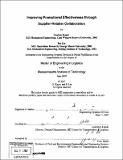Improving promotional effectiveness through supplier-retailer collaboration
Author(s)
Kapur, Gautam, M. Eng. Massachusetts Institute of Technology; Liu, Bin
DownloadFull printable version (20.17Mb)
Other Contributors
Massachusetts Institute of Technology. Engineering Systems Division.
Advisor
Lawrence Lapide.
Terms of use
Metadata
Show full item recordAbstract
In the consumer products industry, retail chains and manufacturers run promotions to maintain consumer and brand loyalty. The two major issues in planning and executing promotions are to accurately forecast demand and to control Out-of-Stock at the shelf. This thesis addresses both these issues. At the strategic level, "Collaborative, Planning, Forecasting and Replenishment" is used to define a process for two companies to collaboratively plan and execute promotions. At an operational level, the single period multi-item newsboy concept with a budget constraint is used to define an optimization model that helps determine the right budget and order quantities for products under a promotion at a targeted service level to improve profit or sales. The concept of Supply Contracts is researched to identify some ways that can be used to optimize the whole supply chain rather than just the retailer's. The value of optimal collaboration was confirmed in the results shown by the model. When optimizing the entire chain, the maximize profit optimization model achieved combined profit improvements of 37% as compared to an actual promotion. (cont.) When only the retailer profit was maximized, the optimization model resulted in 5.9% profit improvements for the retailer and 0.3% profit improvements for the supplier as compared to an actual promotion. Finally, the revenue maximization model showed that after a certain point, increasing the budget did not result in increased service levels. This research can also be applied to new product launches, seasonality of products as well as daily replenishments.
Description
Thesis (M. Eng. in Logistics)--Massachusetts Institute of Technology, Engineering Systems Division, 2007. Includes bibliographical references (leaves 60-61).
Date issued
2007Department
Massachusetts Institute of Technology. Engineering Systems DivisionPublisher
Massachusetts Institute of Technology
Keywords
Engineering Systems Division.